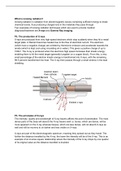Summary
Summary Unit 21 A & B Medical Physics Application - BTEC Extended diploma applied medical science
- Institution
- PEARSON (PEARSON)
Achieved to distinction level without feedback. Covers pass, merit and distinction written at high quality.
[Show more]




